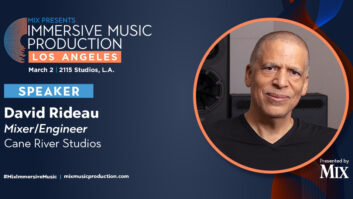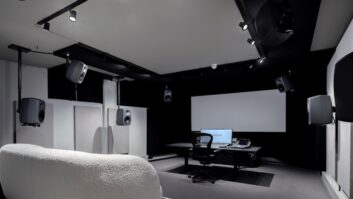
Osaka, Japan (January 31, 2024)—Japanese games developer Capcom has renovated its bitMASTERstudio facility, upgrading the Dubbing Stage for Dolby Atmos projects.
Based in the R&D building near its headquarters in Osaka, Capcom’s bitMASTERstudio is an in-house facility that is used to produce much of the game sound and music for titles such as Monster Hunter and the Resident Evil series. In 2022, Capcom carried out extensive renovations, transforming the facility into the three-studio complex that it is today.
The inspiration for these changes was the overhaul of Capcom’s Dynamic Mixing Stage: GOLD room in 2018, which was designed and constructed by acoustic specialists SONA. According to Kazuya Takimoto, Capcom’s senior sound engineer/mixer, establishing solid room acoustics for this studio achieved such fantastic results that it became the vision for the renovation of Dubbing Stage.
Takimoto adds that the improvements made to the mixing stage allowed for precise positioning of all sound images, thus giving engineers the freedom to focus solely on sound quality and balance during mixing. “This is truly important for producing game audio,” he says. “Consequently, in 2022 we took the decision to renovate Dubbing Stage and add a new room, Dynamic Mixing Stage: SILVER.”
Confetti Launches New London Campus
Capcom chose PMC loudspeakers for the new Dolby Atmos 7.1.4 immersive audio Dubbing Stage, comprising PMC IB2S XBD-A II stereo speakers, PMC6-2 monitors for the height and rear/horizontal positions and four PMC8 subwoofers.
SONA was again responsible for the redesign of Dubbing Stage, which now has a completely renewed interior structure and an exciting new aesthetic with the theme of an “adult social space.” Looking more like a nightclub than a typical in-house games studio, Dubbing Stage has a crescent-shaped panel at the back of the console, which was installed to hide the base of the speakers.
Takimoto says he is delighted with the sound of the new studio, which has turned out better than imagined, both in terms of looks and functionality. “People who listen to the sound in this room all exclaim ‘Wow!’ in unison,” he says. “I once visited Sony Computer Entertainment’s Santa Monica Studio during an AES show in Los Angeles and felt envious of the environment where they create game audio. However, after the renovation, our new studio has become something to be proud of on a similar level.”







